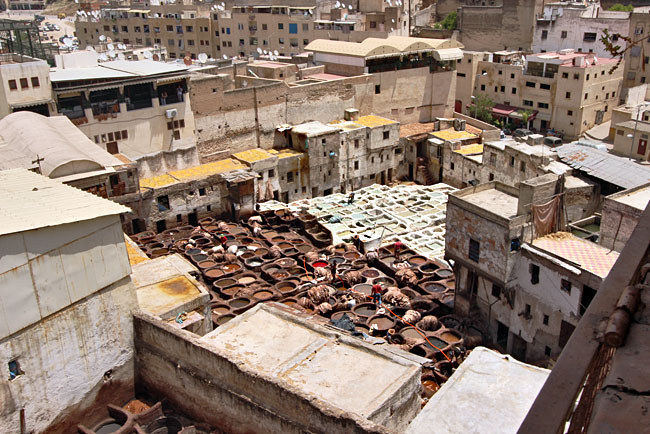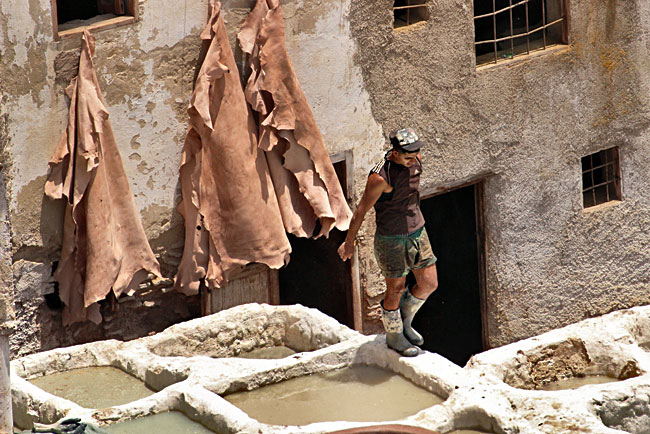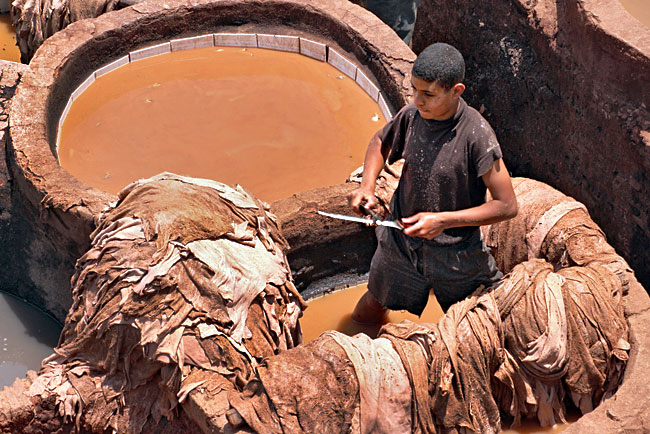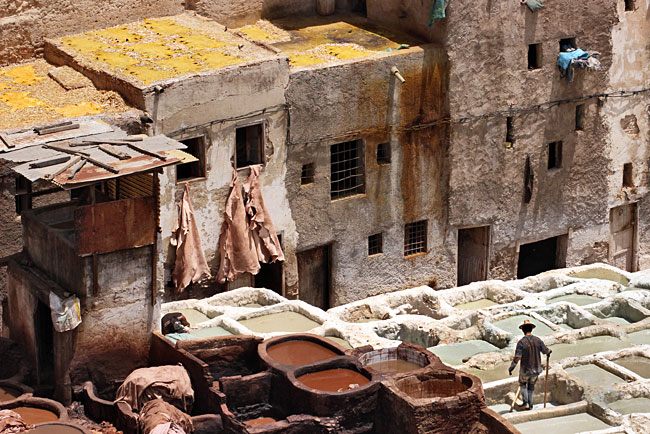An employee handed us each a sprig of mint as we filed into the door of the Chouara Tannery. “Oh, they’re going to make tea for us, how nice,” I thought. I picked my way up the dark, narrow stairway, emerging three flights later into an open-air leather goods shop, where we were led to a terrace overlooking the tannery pits. The stench of rotting flesh and ammonia hit me full-force. Sheepishly, I held the mint under my nostrils, realizing it was meant to help mask the odor that emanated from the pits below.

Chouara Tannery, largest of the three tanning pits of Fez, Morocco, was built in the 11th century and leather goods have been produced there using the exact same method for more than a thousand years. Skins are first placed into the white vats, which contain a mixture of water, limestone, and pigeon droppings. The limestone helps to remove hair from the skins while the acid in the pigeon droppings softens the hides. Three days later the skins are removed and washed, after which they are placed in the dying pits.



The colors in the tanning pits of Fez vary from day to day. During my first visit they were mostly shades of brown but the second time colors ranged from blood red to white, with a little of everything in between. Dye colors are all derived from natural products: red from the poppy flower, orange from henna, blue from indigo, and yellow from saffron, but because saffron is so expensive yellows are produced by hand-rubbing a small amount of the spice mixed with oil into the hides. Other colors are all produced in the pits. Men in skimpy shorts, many with bare feet and legs, stand thigh-high in the dye solutions and agitate the hides like human washing machines. When the desired colors have been achieved the skins are pulled out of the pits, trimmed, and laid out to dry on surrounding rooftops before being moved inside for cutting and sewing.
After this brief orientation on the terrace, our group was led into the showroom and the pressure to buy commenced. Butter soft leather jackets, belts, handbags, suitcases, and slippers stacked to the ceiling were pulled down and laid out for our perusal. One salesman pulled four footstools from a stack and invited me to touch each one; except for design and color they looked the same, but to the touch they were very different, depending upon whether they had been made from camel, sheep, cow, or goat hides.

As a perpetual traveler with no permanent home I had no interest in buying and somehow, the salespeople sensed immediately that that I wasn’t a potential customer. They left me to wander, focusing instead on those who showed interest. Prices started high because customers were expected to negotiate, but as I eavesdropped on the process it was obvious that some were more comfortable with bargaining than others. Some paid half of the original asking price, while others paid as little as a third. But in every case, the final price was much less than what it would have been in the U.S. and the quality seemed quite high. You just had to be able to tolerate the smell to get the bargain.
I was a guest of Best of Morocco Tours during my stay in the Sahara. However, the receipt and acceptance of complimentary items or services will never influence the content, topics, or posts in this blog. I write the truth, the whole truth, and nothing but the truth.

I look at leather goods in a totally different way since learning about that tannery back in 2011. I was so sad to have learned that these workers make between $5 to 8…a day… and they endure this smell every day. I can\’t imagine the long-term affects of the gases they ingest, especially considering that the water / mixture in the vats have not been changed for well over 500 years according to one of the workers who actually was willing to talk about it. I am thankful to live in such a manner where I can purchase leather goods (motorcycle jacket, boots, gloves, etc.), but as for a fashion necessity, I can no longer wear leather thinking about the conditions, workers, and quality of life for them and their families. It has made a positive change in my life when it comes to being thankful along with not being frivolous/vain, along with not taking anything/anyone for granted. My trip was a life changer.
Hi Nino: I know what you mean. The entire time I was there, all I could think about was how the working conditions were shortening the lives of the workers, and how anyone could be expected to endure such conditions. Definitely made me think hard about buying leather. I don’t think I’ve bought anything in leather since that day.
Many ways to think about this. I gives them an income and Im sure they are grateful to be part of this. This is what puts the bread and butter on their table. It probably is handed down to father and son. Its honest work, yes they work hard, yes the smell is horrible, but they are working. Maybe we need to buy leather now that we know the process and to these young men are able to provide a livlng for themselves . So many ways to think about it. They are proud that they are working.
Hi Gerry. You and I agree on one thing. There is always more than one way to think about these things, and as Westerners we can’t always see all sides of the issue.
I think we should buy their product. This is how we honor and respect them for their hard work and conditions that they are exposed to. If we stop buying leather how would they make a living. Something to think about.
I visited this tannery in May 1983, but from a greater distance. It’s really something to see, and knowing that this same process has been used for centuries is just incredible. Thank you!
You’re welcome, Martha. It was really astonishing to see. I just can’t imagine making a living this way.
Interesting, but I shudder to think of the place.
It was definitely intense. Made me wonder what the average lifestyle of t=a worker was.
Hello, was wondering how much should I expect to pay for a tailored women’s leather jacket, sz xs? Going in October and was curious about prices. Also, can you buy fashionable leather boots, see mostly slippers? Thanks so much.
Tracy
I really don’t know, Tracy. Since I travel full time without a home, I didn’t shop. But from what I could see, people were paying hundreds of dollars for long leather coats. Boots were definitely available.
Good Day
We are looking for Sheep Raw Wool
Kindly update if you have any source from tannery house who can offer us Sheep Wool
Awaiting your feedback
[email protected]
Fez was definitely one of my favorite cities in Morocco that I visited- the medina is simply incredible. Visiting the tanneries was a truly unique experience for me as well. Thanks for sharing!
You’re welcome, Bridget. So glad you enjoyed my story.
Could you kindly avail me with Chouara Tannery in Fez including contact phone numbers
So sorry Ado, but I have no contact info for the tannery.
Wow, definitely interesting. I can’t imagine that smell. I always feel uncomfortable in those situations where you just know they want you to buy something but you know you won’t. I’m glad they left you alone at that point and didn’t try to pressure you into it.
We show our respect and honor them for their hard work by buying a small trinket made out of leather.
Ugh, I’m so bad at haggling. I guess I just need more practice, but I am just terrible at it. In my head I know that you are supposed to haggle but I just feel like I’m devaluing their products. It’s all in my head, I know, but I just can’t stop thinking that way.
Hi Darla: I know what you mean. At first, I was uncomfortable with haggling, but the more I learn about these types of cultures the more used to it I’ve become. It is expected, and certainly not an insult. Try your hand at it some time – offer half of what they are asking and stick to your guns, right down to walking away if you must. But only do it if it is a product you intend to buy if they meet your price.
@Heather: I love haggling when visiting countries where it is a normal thing. But actually only for a few weeks, afterwards I am quite happy to go back and pay the asked price (knowing that it is the fair price for everyone). 🙂
I was staggered by this sight when I first saw it. The conditions seem unchanged from 100s of years ago…
Hi Mark: Yes, I had the same reaction. Not sure if that’s good or bad, but they certainly do make gorgeous products.
We visited as well, while In Fez and the smell and the quality both surprised us (but in different ways). We definitely followed or noses to the tannery! That’s wonderful that you could see some different colours in the pits. You’re right about the finished goods: wonderfully soft and fantastically coloured.
Hi Heather – The leathers were absolutely gorgeous. If I had a home to return to I would not have been able to resist buying something. Sometimes, being a perpetual traveler works to my benefit in that way.
When we were in the souk in Agadir we did buy a leather shoulder bag for my daughter but luckily we had a local with us who haggled hard on our behalf and we trusted that we were paying a fair price.
LOL Heather – your “local” probably made a 50-60% commission on the price he negotiated. I’ve spoken to several in-the-know tour operators and that’s what they’ve told me is the going rate.